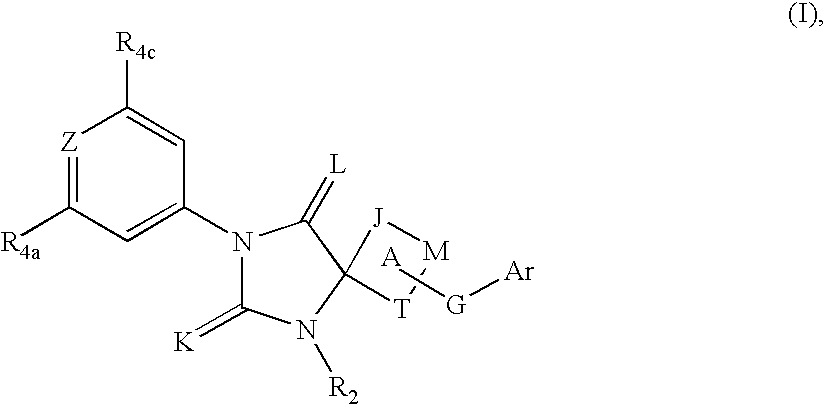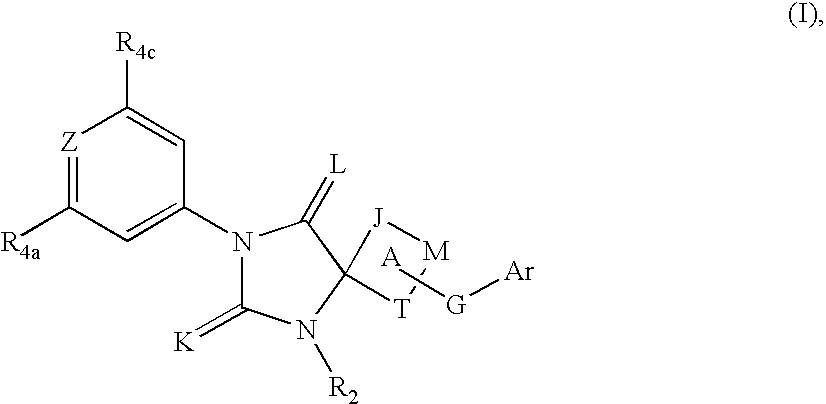Spiro-hydantoin compounds useful as anti-inflammatory agents
a technology of hydantoin and spirohydantoin, which is applied in the field of spirohydantoin compounds, can solve the problems of chronic inflammatory states, poor wound healing, and patients are unable to mount a normal inflammatory or immune response, so as to increase the efficacy of administration and reduce the dosage. , the effect of adding and synergistic effects
- Summary
- Abstract
- Description
- Claims
- Application Information
AI Technical Summary
Benefits of technology
Problems solved by technology
Method used
Image
Examples
examples
[0217]The following Examples illustrate embodiments of the inventive compounds and starting materials, and are not intended to limit the scope of the claims. For ease of reference, the following abbreviations are used herein:
Abbreviations
[0218]AlCl3=aluminum chloride[0219]Ac2O=acetic anhydride[0220]AcONa=sodium acetate[0221]bp=boiling point[0222]CH3CN=acetonitrile[0223]DCC=dicyclohexylcarbodiimide[0224]DCE=dichloroethane[0225]DCM=dichloromethane[0226]DMAP=4-dimethylaminopyridine[0227]DIPEA or DIEA=N,N-diisopropylethylamine[0228]DME=1,2-dimethoxyethane[0229]DMF=dimethyl formamide[0230]EDCI=1,3-dimethylaminopropyl)-3-ethylcarbodiimide[0231]Et2O=diethyl ether[0232]HOBT=1-hydroxybenzotriazole[0233]EtOAc=ethyl acetate[0234]EtOH=ethanol[0235]g=gram(s)[0236]HCl=hydrochloric acid[0237]KOH=potassium hydroxide[0238]K2CO3=potassium carbonate[0239]l=liter[0240]LiAlH4=lithium aluminum hydride[0241]MeCN=acetonitrile[0242]MeOH=methanol[0243]MgSO4=magnesium sulfate[0244]NaH=sodium hydride[0245]Na2S...
preparation 1
4-(4-Bromophenyl)-4-oxobutyric acid
[0261]
[0262]AlCl3 (128.8 g, 0.97 mol) was added by portions within 20 min to a suspension of succinic anhydride (44.3 g, 0.44 mol) and bromobenzene (100 ml, 0.99 mol) in DCM (500 ml) while the reaction flask was cooled in a water bath. After 1 h30 min at RT, the reaction mixture was refluxed for 2 h. After cooling, the reaction medium was slowly poured into a mixture of ice (1.5 l) and concentrated HCl (100 ml). The precipitate was washed twice with water, with isopropanol, and finally with pentane. After drying 4-(4-bromophenyl)-4-oxobutyric acid was obtained as an off-white solid (86.4 g, mp=148° C.). 1H NMR (CDCl3): 7.85 (2H, d, J=8.5 Hz), 7.62 (2H, d, J=8.5 Hz), 3.28 (2H, t, J=6.5 Hz), 2.82 (2H, t, J=6.5 Hz).
preparation 2
4-(4-Bromophenyl)-4-oxobutyric acid methyl ester
[0263]
[0264]4-(4-Bromophenyl)-4-oxobutyric acid (86.4 g, 0.336 mol) (Preparation 1) in MeOH (1.7 l) containing H2SO4 (86 ml) was refluxed for 21 h. After cooling, the light precipitate was filtered off and the reaction mixture concentrated to dryness. The obtained solid was placed in water and extracted twice with EtOAc. The organic layer was washed with diluted NaOH and twice with brine, dried over Na2SO4 and concentrated to yield the desired 4-(4-bromophenyl)-4-oxobutyric acid methyl ester as a low melting point solid (87.5 g, mp=50° C.). 1H NMR (CDCl3): 7.85 (2H, d, J=8.5 Hz), 7.60 (2H, d, J=8.5 Hz), 3.71 (3H, s), 3.28 (2H, t, J=6.5 Hz), 2.76 (2H, t, J=6.5 Hz).
PUM
 Login to View More
Login to View More Abstract
Description
Claims
Application Information
 Login to View More
Login to View More - R&D
- Intellectual Property
- Life Sciences
- Materials
- Tech Scout
- Unparalleled Data Quality
- Higher Quality Content
- 60% Fewer Hallucinations
Browse by: Latest US Patents, China's latest patents, Technical Efficacy Thesaurus, Application Domain, Technology Topic, Popular Technical Reports.
© 2025 PatSnap. All rights reserved.Legal|Privacy policy|Modern Slavery Act Transparency Statement|Sitemap|About US| Contact US: help@patsnap.com



